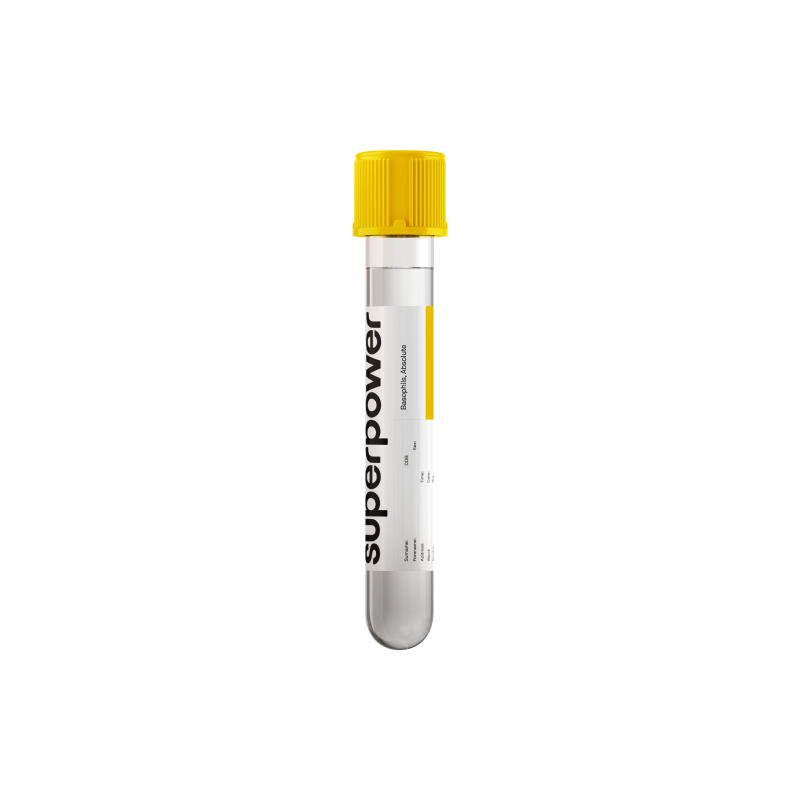By quantifying these rare histamine-carrying white blood cells, the test sharpens context for allergies, inflammation, thyroid shifts, infections, and bone marrow conditions. Interpreted with eosinophils, IgE, CRP, and thyroid labs, it helps connect symptoms like hives, wheeze, or fatigue to underlying biology.
Key Benefits
- Measure basophils, white cells that drive allergy and inflammation.
- Spot basophilia that flags ongoing allergy, chronic inflammation, or parasite exposure.
- Clarify causes of itch, hives, wheeze, or nasal congestion alongside symptoms.
- Guide care by revealing steroid effects; corticosteroids typically lower basophil counts.
- Flag patterns suggesting myeloproliferative disease when counts stay high with elevated WBCs.
- Track trends to see if allergic inflammation persists or resolves over time.
- Differentiate allergy from infection by pairing results with eosinophils and neutrophils.
- Best interpreted with a full CBC differential and your clinical symptoms.
What is Basophils, Absolute?
Basophils, Absolute is the total number of basophils circulating in your blood at the time of the test. Basophils are rare white blood cells (granulocytes) produced in the bone marrow from the myeloid lineage. They spend a short time in the bloodstream and can enter tissues. Their cytoplasm is packed with dark granules containing histamine and other signaling chemicals, and their surface carries high‑affinity receptors for allergy antibodies (IgE via FcεRI). “Absolute” means a direct cell count rather than a percentage of all white cells.
Basophils are rapid responders in allergic reactions and in defense against parasites. When allergens bind and cross‑link IgE on their surface, basophils release granule contents (degranulation) and make lipid mediators (leukotrienes) that open blood vessels, increase leakiness, and recruit other immune cells. They also secrete immune‑shaping signals such as interleukin‑4 and interleukin‑13 (IL‑4, IL‑13), steering the system toward a type 2 response and prompting B cells to make IgE (class switching). In practical terms, the absolute basophil count reflects the circulating pool of these mediator‑rich cells available to participate in immediate hypersensitivity and parasite‑focused immunity.
Why is Basophils, Absolute important?
Basophils, Absolute measures how many basophils—rare white blood cells loaded with histamine and other mediators—are circulating. They act as sentries at body surfaces, amplifying allergy-type (IgE/Th2) responses and helping defend against certain parasites. Because they are so scarce, the typical reference range is tiny, often close to zero, and in healthy people “best” tends to sit toward the low end of normal rather than higher.
When the count falls below the usual band, it rarely causes symptoms on its own. It often reflects a whole‑body stress signal: surges of endogenous cortisol, acute infections, or exposure to glucocorticoid medicines temporarily move basophils out of circulation or suppress their release from marrow. In pregnancy, lower counts are common from hemodilution and hormonal shifts and usually have no clinical impact. These patterns track adrenal‑immune balance more than a basophil problem per se.
When the count is higher than expected, it points to ongoing immune activation or marrow overproduction. Allergic conditions such as hay fever, asthma, and eczema can raise basophils, bringing histamine‑related itch, congestion, or wheeze. Chronic parasitic infections and hypothyroidism are also classic associations. Marked or persistent elevations can occur in myeloproliferative neoplasms (for example, chronic myeloid leukemia), where broader signs—fatigue, night sweats, enlarged spleen, abnormal platelets—reflect a bone‑marrow–level process. Children with atopy may show modest increases during flares.
Big picture: the absolute basophil count is a small but telling lens on immune polarity, marrow health, and endocrine context. Interpreting it alongside eosinophils, neutrophils, platelets, thyroid status, and clinical symptoms reveals whether it mirrors transient allergic activity, hormone effects, infection, or a primary marrow disorder, and how that may influence long‑term inflammatory burden.
What Insights Will I Get?
Basophils, Absolute measures the number of basophils circulating in your blood. Basophils are rare white blood cells that coordinate allergic and parasite defenses by releasing histamine, leukotrienes, and cytokines (notably IL‑4/IL‑13) via IgE receptors. Their activity influences vascular permeability, airway reactivity, skin responses, and the broader “type 2” immune tone that shapes inflammation and tissue repair.
Low values usually reflect transient redistribution or suppression of basophils from stress hormones (cortisol), acute inflammation, or exposure to glucocorticoids. They are also often lower during pregnancy. On their own, low counts rarely cause symptoms and mainly indicate a dampened type 2 immune signal; when part of a broader low white cell pattern, they can accompany bone marrow suppression or severe illness.
Being in range suggests balanced type 2 immunity without chronic allergic activation, adequate marrow production, and stable vascular‑tissue signaling. Because basophils are scarce by design, typical results cluster in the low to mid portion of the reference range, and stability over time matters more than small single‑test shifts.
High values usually reflect increased production or mobilization driven by allergic sensitization (asthma, rhinitis, eczema), helminthic parasitic infections, chronic inflammation, or post‑splenectomy states. Marked, persistent basophilia can signal a myeloproliferative process such as chronic myeloid leukemia, especially when other blood counts are also abnormal.
Notes: Counts vary with recent infections, allergic flares, and corticosteroid use. Pregnancy can modestly lower values. Because basophils are very few, automated assays have higher imprecision; absolute counts are more interpretable than percentages, and trends across repeated tests provide the clearest context.



.svg)



.png)
.png)
.png)
.png)








